
BOOK REVIEW 136 – I Am Rohingya by Saiful Huq Omi
Oct 27, 2018 Book Review
Each refugee drama is divided into three stages, the experience of crimes, the experience of expulsion and the experience of refugee life, and all three stages carry special traumas with them.
The tragedies that have happened in the 20th century and are still happening in the beginning of the 21st century have the same scenario; to dehumanize and terrorize one group and force it to move from its centuries-old fireplace, while removing all traces of Islamic life. In the last thirty years, the feeling is that religious and ethnic settlements are intensifying. Through the media and the Internet, these tragedies are shown to the whole world, but the world community reacts rarely or inadequately to such events. In the early 1990s, we were shocked by the genocide against Bosnian Muslims, and soon afterwards, a crime against the Muslims of Kosovo. The tragedy of the Palestinian people is permanent and synonymous with the suffering of Muslims. On the other hand, at the beginning of the 21st century, we witnessed the suffering of people throughout the Arab world, while today tragedy is present also in the East.
The tragedy of the Rohingyas in Burma is especially pronounced since there is a feeling that they do not belong to anyone and that nobody wants to protect them. The Burmese regime that commits a crime seeks to completely devalue Rohingyas as human beings and as a nation, therefore silently allowing and encouraging all the crimes against them.
Saiful Huq Om speaks through photographs about the three stages of refugee drama mentioned at the beginning of this review. There are 135 recognized ethnic groups in Burma, Rohingyas are not recognized and therefore they are the number 136.
Saiful Huq Omi uses dramatic black and white photography in order to document Rohingya's cruel reality. More importantly, the author described each photograph, how it came to be, and what was the fate of those whom he photographed. Horrifying testimonies leave a mark, and in some ways are even more shocking due to the fact that Rohingyas are not given any perspective, nor are given the opportunity to get a chance for a normal life, through provision of medical care and any kind of socialization.
Nevertheless, Saiful Huq Omi also presents positive examples of the lives of Rohingya refugees in England, where children are given a chance to grow up a normal human beings. This book is a shocking testimony and a call to action to help Burma's 136th nation.
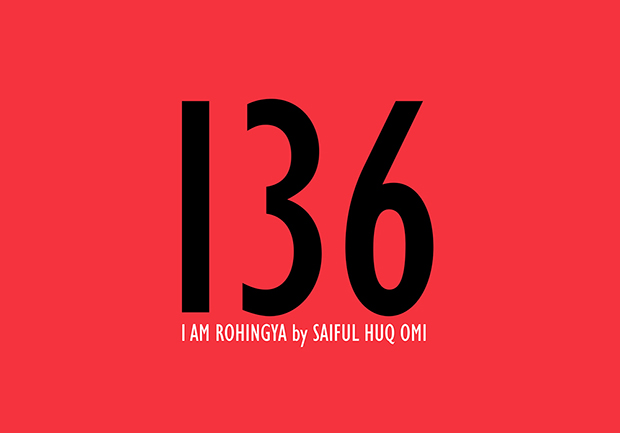 The cover of the book '136 – I Am Rohingya' by Saiful Huq Omi / Image credits: SaifulHuq Omi/Schilt Publishing
The cover of the book '136 – I Am Rohingya' by Saiful Huq Omi / Image credits: SaifulHuq Omi/Schilt Publishing
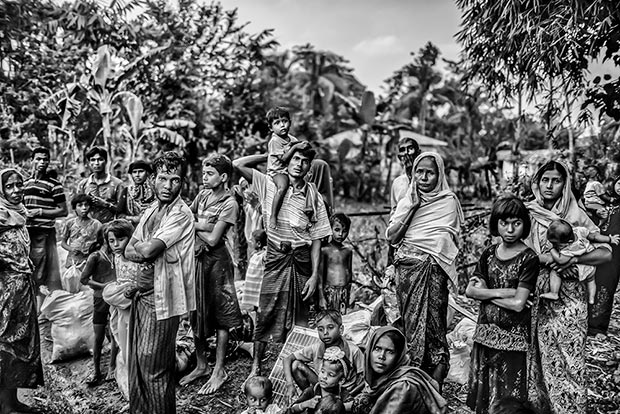 The Rohingyas arrive in Cox's Bazar, Bangladesh, escaping from the 2017 Rohingya persecution in Myanmar. / Image credits: SaifulHuq Omi/Schilt Publishing
The Rohingyas arrive in Cox's Bazar, Bangladesh, escaping from the 2017 Rohingya persecution in Myanmar. / Image credits: SaifulHuq Omi/Schilt Publishing
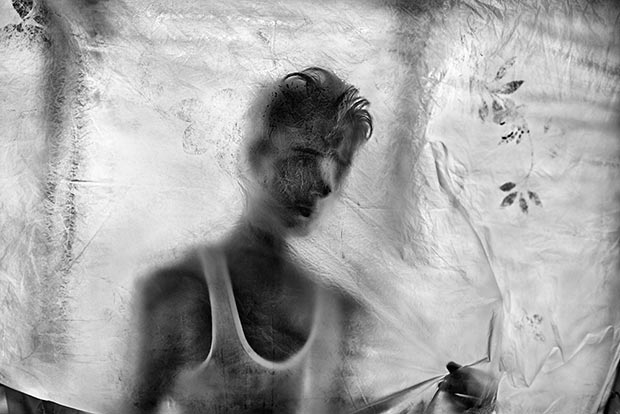 Just a week before this photograph was taken in late 2014, Saydul Islam came to Malaysia by boat. There he suffered debilitating and recurring nightmares about the treacherous month-long journey he had taken from Burma to Malaysia via a smugglers camp in Thailand. / Image credits: SaifulHuq Omi/Schilt Publishing
Just a week before this photograph was taken in late 2014, Saydul Islam came to Malaysia by boat. There he suffered debilitating and recurring nightmares about the treacherous month-long journey he had taken from Burma to Malaysia via a smugglers camp in Thailand. / Image credits: SaifulHuq Omi/Schilt Publishing
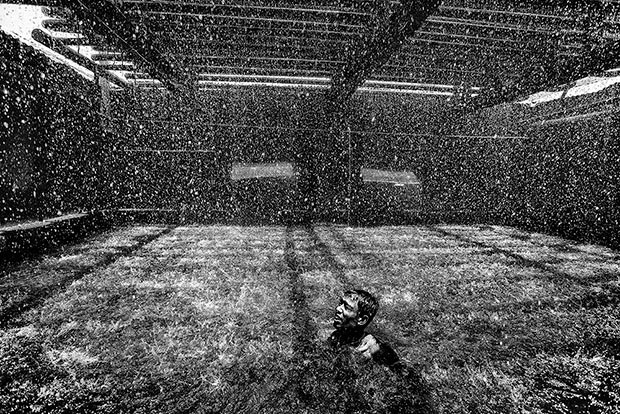 A Rohingya worker in an ice factory in Cox’s Bazar, Bangladesh. Because it is illegal for Rohingyas to work in Bangladesh, they work informally and are exploited by their employers. Tensions between Bangladeshis and the Rohingyas are growing, with Bangladeshis complaining that the Rohingyas are ‘stealing’ their jobs. / Image credits: SaifulHuq Omi/Schilt Publishing
A Rohingya worker in an ice factory in Cox’s Bazar, Bangladesh. Because it is illegal for Rohingyas to work in Bangladesh, they work informally and are exploited by their employers. Tensions between Bangladeshis and the Rohingyas are growing, with Bangladeshis complaining that the Rohingyas are ‘stealing’ their jobs. / Image credits: SaifulHuq Omi/Schilt Publishing
 Many unregistered Rohingya refugees in Bangladesh work as fishermen in Cox’s Bazar. They have revolutionized the fishing industry. Years ago, when the industry was dependent solely on Bangladeshi fishermen, it was difficult to find people who were willing to go to sea year-round, due to the great risks involved. As the Rohingyas are so desperate for work, they have little option but to go to sea during the off-season, when conditions are rough and dangerous. Consequently, fishing in the seas off Bangladesh now happens almost all year round. / Image credits: SaifulHuq Omi/Schilt Publishing
Many unregistered Rohingya refugees in Bangladesh work as fishermen in Cox’s Bazar. They have revolutionized the fishing industry. Years ago, when the industry was dependent solely on Bangladeshi fishermen, it was difficult to find people who were willing to go to sea year-round, due to the great risks involved. As the Rohingyas are so desperate for work, they have little option but to go to sea during the off-season, when conditions are rough and dangerous. Consequently, fishing in the seas off Bangladesh now happens almost all year round. / Image credits: SaifulHuq Omi/Schilt Publishing
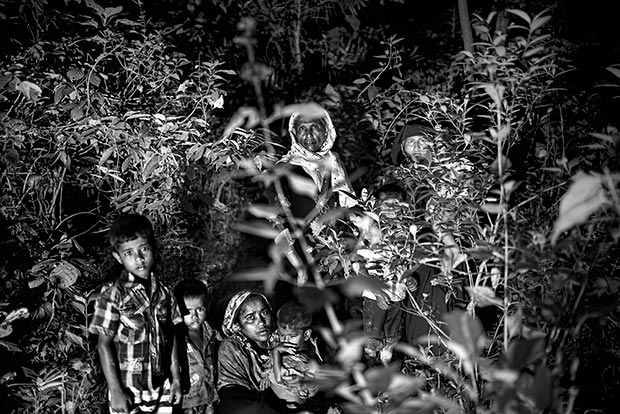 At 3:00 am, this family finally managed to get into Bangladesh. They waited in the jungle for their smuggler to come and take them to a safe house. Shortly after this photograph was taken in 2012, the border guards arrested the entire family for ‘illegally’ entering Bangladesh. The next morning, they were pushed back to Myanmar. / Image credits: SaifulHuq Omi/Schilt Publishing
At 3:00 am, this family finally managed to get into Bangladesh. They waited in the jungle for their smuggler to come and take them to a safe house. Shortly after this photograph was taken in 2012, the border guards arrested the entire family for ‘illegally’ entering Bangladesh. The next morning, they were pushed back to Myanmar. / Image credits: SaifulHuq Omi/Schilt Publishing
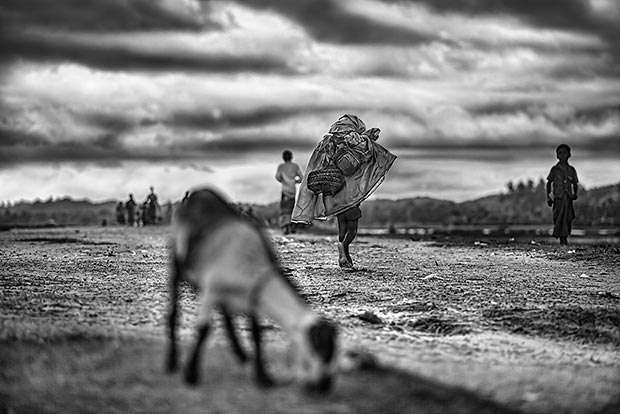 Shamlapur, a locality isolated from the Bangladeshi mainland, has been home to Rohingya refugees for many years. Tens of thousands of Rohingyas have settled here and work as fishermen. / Image credits: SaifulHuq Omi/Schilt Publishing
Shamlapur, a locality isolated from the Bangladeshi mainland, has been home to Rohingya refugees for many years. Tens of thousands of Rohingyas have settled here and work as fishermen. / Image credits: SaifulHuq Omi/Schilt Publishing
 All children are entitled to a name and the right to acquire a nationality from birth. Yet for many decades, the Rohingyas have been a stateless community, be it in Burma, Bangladesh, Malaysia or elsewhere. They are not considered to be legal citizens of any state. Despite the existence of safeguards against statelessness in the domestic laws of some countries, many children, like this boy born in Malaysia, start their lives as children of ‘nowhere’. / Image credits: SaifulHuq Omi/Schilt Publishing
All children are entitled to a name and the right to acquire a nationality from birth. Yet for many decades, the Rohingyas have been a stateless community, be it in Burma, Bangladesh, Malaysia or elsewhere. They are not considered to be legal citizens of any state. Despite the existence of safeguards against statelessness in the domestic laws of some countries, many children, like this boy born in Malaysia, start their lives as children of ‘nowhere’. / Image credits: SaifulHuq Omi/Schilt Publishing
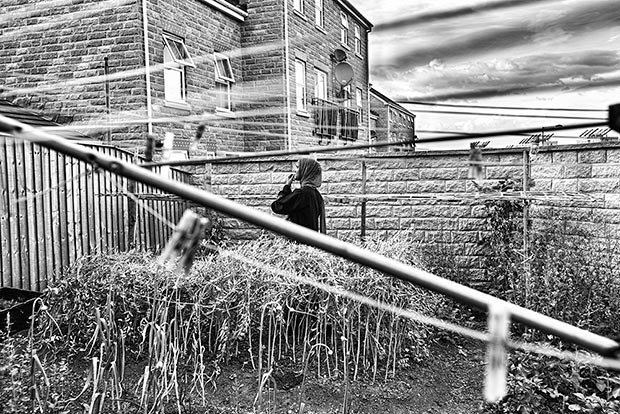 Rahima Khatun is a widow. When she came to Bradford in the UK, she and her daughter were both severely sick. They received medical treatment in Bradford and are now living healthy lives. If they had stayed in Bangladesh, they – like others – may have died for lack of treatment. / Image credits: SaifulHuq Omi/Schilt Publishing
Rahima Khatun is a widow. When she came to Bradford in the UK, she and her daughter were both severely sick. They received medical treatment in Bradford and are now living healthy lives. If they had stayed in Bangladesh, they – like others – may have died for lack of treatment. / Image credits: SaifulHuq Omi/Schilt Publishing
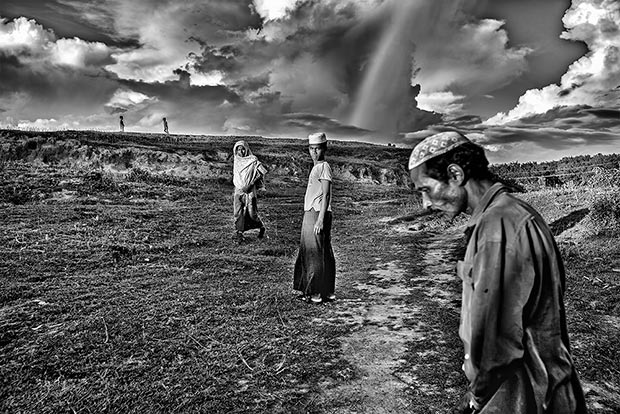 For decades now, Bangladesh has been home to some 32,000 registered refugees living in camps, and an estimated 100,000 unregistered Rohingyas in makeshift sites. A further 200,000 to 300,000 Rohingya refugees live an irregular existence in
different parts of Cox’s Bazar and adjacent districts. / Image credits: SaifulHuq Omi/Schilt Publishing
For decades now, Bangladesh has been home to some 32,000 registered refugees living in camps, and an estimated 100,000 unregistered Rohingyas in makeshift sites. A further 200,000 to 300,000 Rohingya refugees live an irregular existence in
different parts of Cox’s Bazar and adjacent districts. / Image credits: SaifulHuq Omi/Schilt Publishing
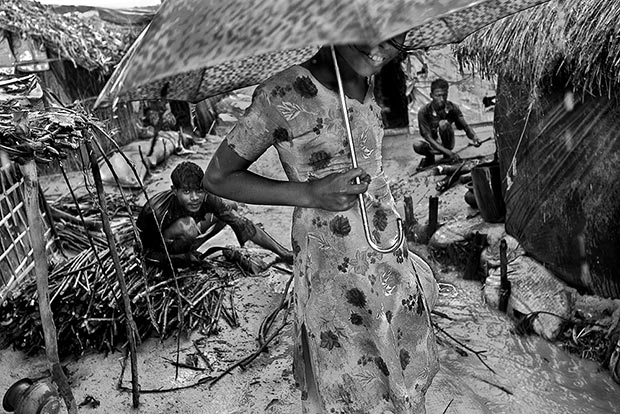 When it rains in the unregistered camps in Bangladesh, the walkways become little rivers. When it rains too much, there is a risk of a landslide as the hillsides have been deforested for firewood. Landslides may engulf the homes of the refugees, but the Rohingyas have no place else to go. / Image credits: SaifulHuq Omi/Schilt Publishing
When it rains in the unregistered camps in Bangladesh, the walkways become little rivers. When it rains too much, there is a risk of a landslide as the hillsides have been deforested for firewood. Landslides may engulf the homes of the refugees, but the Rohingyas have no place else to go. / Image credits: SaifulHuq Omi/Schilt Publishing
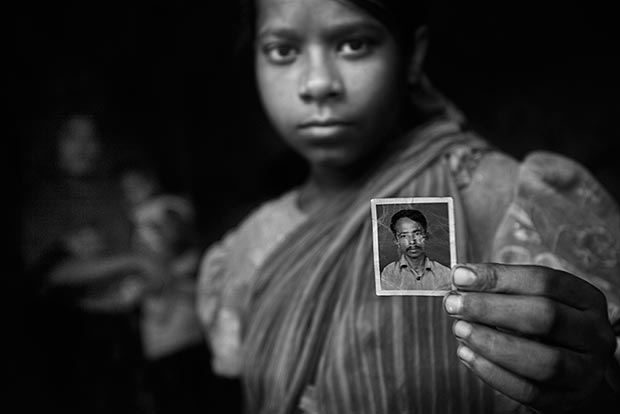 The Rohingyas tend to do what are known as ‘3D’ jobs – those that are Dirty, Dangerous and Degrading. Some employers further exploit their dire situation by paying Rohingya workers, such as these working on a high-rise construction site in Malaysia, very low wages or no wages at all. / Image credits: SaifulHuq Omi/Schilt Publishing
The Rohingyas tend to do what are known as ‘3D’ jobs – those that are Dirty, Dangerous and Degrading. Some employers further exploit their dire situation by paying Rohingya workers, such as these working on a high-rise construction site in Malaysia, very low wages or no wages at all. / Image credits: SaifulHuq Omi/Schilt Publishing
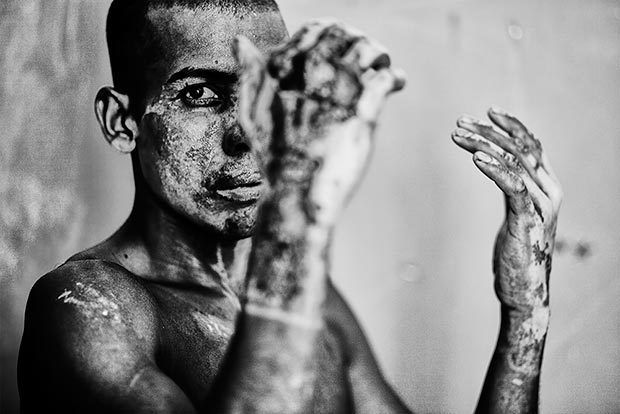 In 2011, Sheikh Mohammad arrived in Malaysia and took a job in a tyre recycling factory. Not long after, he suffered an accident in the factory, which caused third-degree burns on over 60% of his body. He received no compensation from his employer, nor assistance towards the cost of his medical treatment. He also lost his income as he could month after the accident. / Image credits: SaifulHuq Omi/Schilt Publishing
In 2011, Sheikh Mohammad arrived in Malaysia and took a job in a tyre recycling factory. Not long after, he suffered an accident in the factory, which caused third-degree burns on over 60% of his body. He received no compensation from his employer, nor assistance towards the cost of his medical treatment. He also lost his income as he could month after the accident. / Image credits: SaifulHuq Omi/Schilt Publishing
'136 – I am Rohingya' is published by Schilt Publishing. The book is available in stores and online for €45 and €55 for a signed copy.
Comments
Add a comment